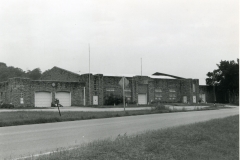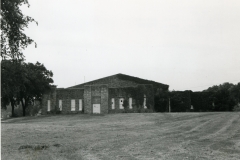| Address: | First and Cleveland Streets, Pawnee, Oklahoma | County: | Pawnee |
| Started: | January 1936 | Completed: | May 1937 |
| Agencies: | WPA | NRHP: | May 20, 1994 |
Current Usage:
Abandoned
Description:
This armory is a single-story, rectangular (149′ x 237′) structure constructed of rusticated and coarsed native stone of buff colors. The central portion of the building has an arched roof, while elsewhere the roof is flat. Parapets are found on all sections of the roof. Pilasters on doorways, corners, and walls provide decorative relief and give the structure a “fortress” appearance. The garage entrances contain segmental arches. The elongated metal encased windows have new screens inserted.
As a WPA building, the armory is exceptional for its quality of workmanship. Few buildings were comparable in reference to scale. The armory is unique, architecturally speaking, within the city of Pawnee in terms of type, style, scale, and materials. Construction of this building provided jobs for destitute workers in this area, while infusing wages of some 72,000 man-hours of labor into Pawnee’s economy. The jobs generated by the construction of this building helped maintain the pride of men who thereby found the means to support their hungry families. This WPA armory also contributed to military readiness during World War II.
VERBAL BOUNDARY DESCRIPTION: On a tract of land beginning 1248 feet west of the northeast corner of the NW 1/4, Sec. 5, T 21 N, R 5 E, and go south 416 feet, east 208 feet, north 416 feet, and west 208 feet.
Pawnee received word that it had been chosen for one of the state’s 56 proposed armory projects in June 1935. The federal government already allocated $50,000 for an armory to accommodate Pawnee’s National Guard unit. The Chamber of Commerce, city planning board, and local Guard officers at once began considering building sites. They selected a 2.5 acre plot on Highway 64 on the southeast edge of town. Public donations raised the $1,250 needed, and the land was eventually deeded to the state and the National Guard. Mrs. George A. Waters donated all the stone from sandstone deposits on her farm east of town, a fact some believed influenced federal approval of an armory for Pawnee. The quarrying began in late October 1935 with 54 men employed under the direction of Nick Hawkins. National Guard trucks and Guardsmen transported the stone to the site. Excavation and laying of water lines began late in the year. Actual construction started on January 2, 1936. Under the supervision of Guard Captain Stanley I. Smith, a local builder, and Pawnee County Engineer Oscar Sewell, 36 men dressed and laid the cut stone. The work progressed through 1936, employing at various times 160 laborers from Pawnee and a dozen surrounding communities. These were “men whose families needed the wages to the end that food might be kept upon the tables, and to the further end that the boys and girls might have clothing, shoes and books suitable for continuance in the public schools.”The Pawnee Armory was completed in the spring of 1937 at a cost of $71,319.22. One of the largest armories in the state of Oklahoma, it included a drill hall capable of seating an audience of two thousand. A stage at one end attested to the multiple purposes of the building. Unit quarters consisted of classrooms, administrative offices, storage space, supply rooms, garages, lockers, showers and a concrete arms vault. A rifle range with bullet-proof observation chambers for scorers and observers was built under the stage. The dedication on May 14 attracted thousands. General W. S. Key, state WPA administrator and commander of the Oklahoma National Guard, and Lieutenant Governor and Guardsman James E. Berry were the principal speakers. The local newspaper described the armory building as “the greatest physical accomplishment of the Works Progress Administration in this state” and applauded “its successful prosecution with raw materials and comparatively raw labor.” The open house, reception, and dance featuring Chief Shunatona and his American Indian band marked the acceptance of the Pawnee Armory as a fixture of the Pawnee community. By the end of the same month, the building was already functioning as a meeting hall for the local chapter of the American Legion. [4]
Sources:
- Oklahoma Landmarks Inventory Nomination
- The Living New Deal
- Wikipedia
- National Register of Historic Places Registration Form
- Oklahoma Department of Environmental Quality
Supported Documents:
- WPA Properties Pawnee County – Pawnee Armory
- National Register of Historic Places Support Document
- National Register of Historic Places Nomination Form





Leave a Reply